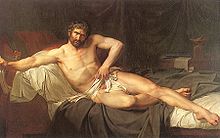
Guillaume Guillon-Lethière
Encyclopedia

Neoclassicism
Neoclassicism is the name given to Western movements in the decorative and visual arts, literature, theatre, music, and architecture that draw inspiration from the "classical" art and culture of Ancient Greece or Ancient Rome...
painter
Painting
Painting is the practice of applying paint, pigment, color or other medium to a surface . The application of the medium is commonly applied to the base with a brush but other objects can be used. In art, the term painting describes both the act and the result of the action. However, painting is...
.
Born in Guadeloupe
Guadeloupe
Guadeloupe is an archipelago located in the Leeward Islands, in the Lesser Antilles, with a land area of 1,628 square kilometres and a population of 400,000. It is the first overseas region of France, consisting of a single overseas department. As with the other overseas departments, Guadeloupe...
in 1760 to a French colonial official named Pierre Guillon and a disenfranchised "mulatto" mother, Lethière has been often written about in the context of French colonial history and the French Revolution
French Revolution
The French Revolution , sometimes distinguished as the 'Great French Revolution' , was a period of radical social and political upheaval in France and Europe. The absolute monarchy that had ruled France for centuries collapsed in three years...
.
At 14 years old, he moved from Guadalupe to France
France
The French Republic , The French Republic , The French Republic , (commonly known as France , is a unitary semi-presidential republic in Western Europe with several overseas territories and islands located on other continents and in the Indian, Pacific, and Atlantic oceans. Metropolitan France...
, and by 17 he had become the student of Gabriel François Doyen
Gabriel François Doyen
Gabriel François Doyen was a French painter, who was born at Paris.His passion for art prevailed over his father's wish, and he became in his twelfth year a pupil of Charles-André van Loo. Making rapid progress, he obtained at twenty the Grand Prix de Rome, and in 1748 set out for Rome...
at the Académie Royale de Peinture et de Sculpture. Lethière won second prize in the Prix de Rome
Prix de Rome
The Prix de Rome was a scholarship for arts students, principally of painting, sculpture, and architecture. It was created, initially for painters and sculptors, in 1663 in France during the reign of Louis XIV. It was an annual bursary for promising artists having proved their talents by...
of 1784 for his painting Woman of Canaan at the Feet of Christ. He entered again two years later, and while he did not win, he succeeding in receiving support to travel to Rome where he further developed his neoclassical style. Lethière remained in Rome for several years, and returned to Paris in 1791 to open a painting studio in direct competition with Jacques-Louis David
Jacques-Louis David
Jacques-Louis David was an influential French painter in the Neoclassical style, considered to be the preeminent painter of the era...
. In 1818 Lethière was finally elected and also awarded the Légion d’honneur, and a year later he became a professor at the École des Beaux-Arts
École des Beaux-Arts
École des Beaux-Arts refers to a number of influential art schools in France. The most famous is the École nationale supérieure des Beaux-Arts, now located on the left bank in Paris, across the Seine from the Louvre, in the 6th arrondissement. The school has a history spanning more than 350 years,...
.
Among his students was Isidore Pils
Isidore Pils
Isidore-Alexandre-Augustin Pils was a French painter.Pils was born in Paris as the son of a soldier. At the age of twelve, he studied with Guillaume Guillon-Lethière for four years...
.
Further reading
- B. Foucart, G. Capy and G. Flrent Laballe, Guillaume Guillon Lethière (Paris and Point-à-Pitre, 1991).
- Darcy Grimaldo Grigsby, "Revolutionary Sons, White Fathers and Creole Difference: Guillaume Guillon Lethière's Oath of the Ancestors of 1822" Yale French Studies 101 (2002): pp. 201–226.
- T. Oriol, Les Hommes célèbres de La Guadeloupe (Basse-Terre, 1935), pp. 39–47.

